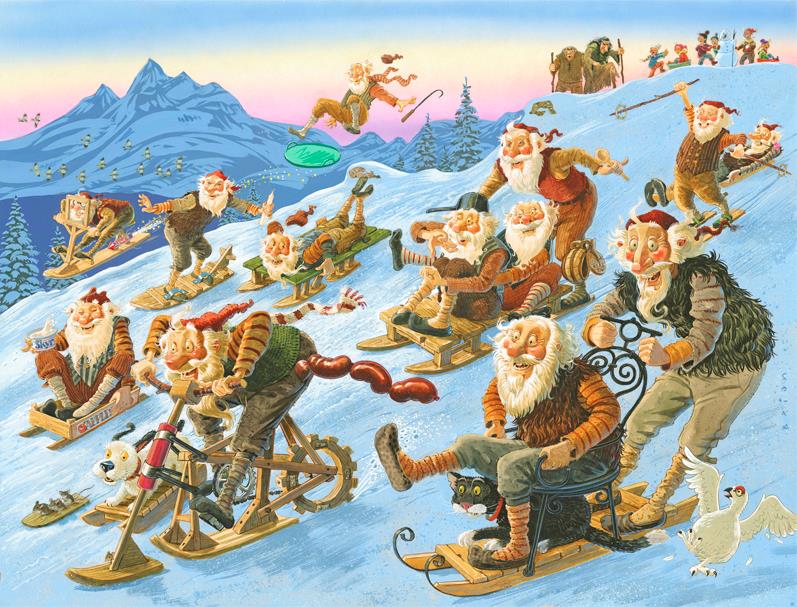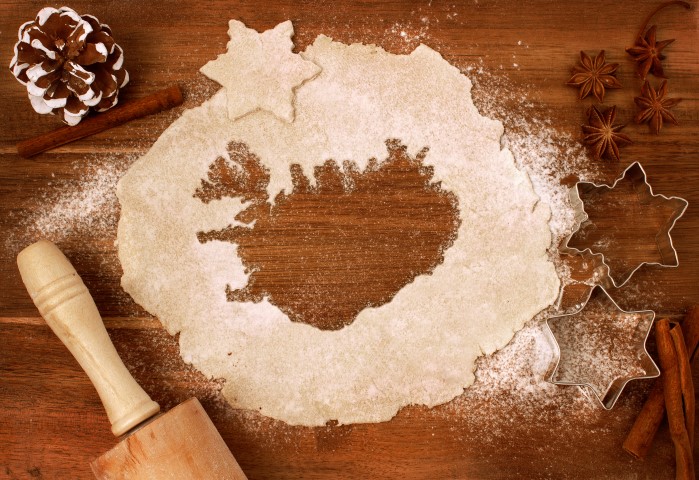In Iceland, Christmas (‘jól’ in Icelandic) is an important, family-oriented holiday with strong traditions. The season, starting in late November and stretching over the New Year, is characterised by a joyful spirit. Enjoy our mini-guide to Icelandic Christmas and New Year celebrations!
Related tours and experiences:
Reykjavík Christmas Walking Tour
Funky Christmas Myths and Traditions
Golden Circle Reykjavík Christmas Walk
Celebrate the New Year With Bonfire and Fireworks
Celebrate the New Year at Sea
Advent in Iceland (Aðventa)
The Advent begins on the fourth Sunday before Christmas and marks the official Christmas season in Iceland. This is when people start decorating their homes with colourful and cosy Christmas lights and other holiday knick-knacks. The lovely lights light up the winter darkness and Icelanders start getting into the holiday spirit. Those weeks leading up to Christmas are no less important than the festivities themselves. People clean and decorate their homes, bake Christmas cookies, write Christmas cards and wrap presents, children go to Christmas parties and friends and colleagues meet up to enjoy sumptuous Christmas buffets (jólahlaðborð) and attend special Christmas concerts.
The Icelandic Yule Lads (Jólasveinar)

Icelandic 13 Yule Lads - © Brian Pilkington
Icelandic children do not receive a visit from the well-known Santa Claus around Christmas. There is no need to feel sorry for them though, because Icelandic children enjoy favours from the 13 Icelandic Yule Lads.
According to Icelandic folklore, these guys are the sons of trolls Grýla and Leppalúði. They live in the mountains but come to town 13 days before Christmas to perform all sorts of mischief, reflected in their names such as Door-slammer and Spoon-licker! Icelandic children leave a shoe on the windowsill for the Yule Lads to fill with goodies each night when they are asleep. They need to be well behaved in order to receive a little something from the Yule Lads. If they are naughty they may wake up to find a potato in their shoe! When all of the Yule Lads have arrived, on Christmas Eve, it is time to start the actual Christmas celebrations. Their mother, Grýla, is a mean and child-eating troll and their pet is the huge and vicious Yule Cat, who lurks around in the snow and eats people who don't receive new clothes to wear before Christmas Eve.
These are the names of the Yule Lads, in the order they come to town:
- Stekkjastaur (Sheep-Cote Clod)
- Giljagaur (Gully Gawk)
- Stúfur (Stubby)
- Þvörusleikir (Spoon Licker)
- Pottasleikir (Pot Scraper)
- Askasleikir (Bowl Licker)
- Hurðaskellir (Door Slammer)
- Skyrgámur (Skyr Gobbler)
- Bjúgnakrækir (Sausage Swiper)
- Gluggagæir (Window Peeper)
- Gáttaþefur (Door Sniffer)
- Ketkrókur (Meet Hook)
- Kertasníkir (Candle Beggar)
A day-by-day Guide to Icelandic Christmas Celebrations

Iceland has many old traditions and customs for celebrating Christmas, which are rooted in the winter solstice celebrations of heathen times. The festive period lasts for 13 days with the main days of celebration falling on the following dates:
23 December – Þorláksmessa
This day is named after Iceland's patron saint, St. Þorlákur. It is tradition to eat putrid skate on this day, although many, especially members of the younger generation, find it a bit too pungent for their taste! For most, this is a day for final decorations, including decorating the Christmas tree, and last-minute shopping - this evening the streets of downtown Reykjavík are filled with people shopping and socialising.
24 December – Christmas Eve (Aðfangadagur)
This is the big day – or evening really. Everybody dresses up in their best clothes. Legend even says that if you don’t get any new clothes for Christmas, you will be devoured by Grýla’s notorious Christmas cat! The church bells ring in Christmas at 18:00, when many people attend mass, followed by a big family dinner.
The most common main courses are hangikjöt (smoked lamb), roast pork, turkey or ptarmigan, accompanied by potatoes, vegetables and gravy in addition to laufabrauð (delicious thin and crispy ‘leaf bread’) and malt og appelsín (a non-alcoholic malt drink mixed with orangeade) to drink. Often, rice pudding is served, either as an entrée or a dessert. An almond is hidden in one of the bowls and whoever gets the almond needs to keep it a secret until everybody is finished - when he or she receives a prize!
After dinner family members gather by the Christmas tree and exchange gifts.
25 December – Christmas Day (Jóladagur)
This is a day to relax, sleep in, perhaps read a book, play games, watch a film or go for a nice walk before another delicious family dinner takes place.
26 December – Boxing Day (Annar í jólum)
This day is much the same as 25 December, relaxed and enjoyable, all about meeting friends and family and enjoying good food.
31 December - New Year's Eve (Gamlárskvöld)
New Year’s Eve in Iceland has achieved almost legendary status due to the huge public fireworks display around midnight. In Iceland, anyone can freely buy and use fireworks, which are commonly bought from rescue teams to support their important work. Come evening, everybody dresses up in their finest clothes and gathers for a festive dinner. After dinner most people attend a nearby bonfire to warm up, perhaps sing a few songs and meet old friends. After the bonfires, everybody gathers around the TV at home to watch a comedy show making fun of the passing year’s political events. When the clock approaches midnight the sound of fireworks banging becomes louder and louder, culminating in a grand display of fireworks emanating from almost every garden and streetcorner, a spectacular sight! After midnight, parties often continue either at home or move to the bars and clubs downtown.
Did you know? Legend says that several magical traditions are supposed to happen on New Year’s Eve. Cows are meant to be able to talk, seals take on human form, the dead rise from their graves and the ‘hidden people’ (elves) move house.
1 January - New Year’s Day (Nýársdagur)
This is a day to relax after yesterday’s festivities! Although some people save their energy for dancing at fancy New Year’s balls on this evening as well.
6 January - Twelfth Night (Þrettándinn)
The twelfth night is also the thirteenth and last day of the traditional Icelandic Christmas season. The last Yule Lad returns to the mountains. Many of the magical traditions associated with New Year's Eve are also supposed to happen at Þrettándinn. One can sometimes see references to this as ‘elf queens and kings’ lead torch-lit parades and people sing elfin songs around bonfires. It is common to use up leftover fireworks from New Year’s Eve to bid Christmas farewell.
Christmas and New Year Holidays in Iceland
Advent, Christmas and New Year is a great time to visit Iceland and experience something truly different!
If you visit in the run-up to Christmas, spend a day or two enjoying the magical atmosphere of twinkling Christmas lights, delicious food, music and shopping in Reykjavík. Then escape to the countryside to wind down and take in the incredible Icelandic landscape.
Gleðileg jól og farsælt komandi ár! Merry Christmas and a Happy New Year!